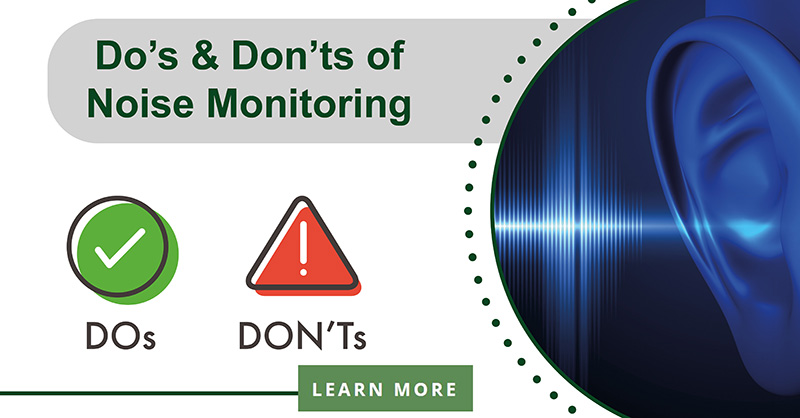
A common question that often gets asked is, should I use a noise dosimeter or a sound level meter (SLM) to determine noise exposure?
Casella explores current occupational noise exposure regulations, and the do's of don'ts of noise measurements within the workplace. Remember, noise monitoring is more than compliance but all about people's health and wellbeing!
Top 10 Dos and Don’ts of Noise Dosimetry
A common question that often gets asked is, should I use a noise dosimeter or a sound level meter (SLM) to determine noise exposure? US occupational noise exposure regulation 29 CFR 1910.95 says “where circumstances such as high worker mobility, significant variations in sound level, or a significant component of impulse noise make area monitoring generally inappropriate, the employer shall use representative personal sampling to comply with the monitoring requirements of this paragraph unless the employer can show that area sampling produces equivalent results”.
And although ‘late to the dosimeter party’ global standards like ISO 9612 Determination of occupational noise exposure also now recognise the use of dosimeters. However, standards invariably tend to lag technology by 5-10 years (or more) and modern dosimeters now have a very similar capability to that of a hand-held SLM including audio recording and octave band frequency analysis. The ANSI S1.25 (R2017) standard for noise dosimeters also pre-dates the introduction of badge-style devices where the microphone is closely coupled to the body of the instrument rather than on a cable (which represented an obvious point of potential failure).
Finally, should a noise dosimeter be type 1 or 2 accuracy? The ANSI standard specifies type 2 but according to the parallel IEC 61252 standard, an accuracy grade is no longer specified but if pressed, you could say that they meet type 2 when the relevant functionality is viewed as an SLM.
OK, that’s the nerdy bit, here’s the practical stuff.
DO
· Remember to fully charge your dosimeter before use or check that there is at least sufficient battery life remaining.
· Field calibrate using an acoustic calibrator before and after use. It ensures the noise dosimeter is functioning correctly and checks there has not been any significant drift during measurements.
· Remember to get your instrumentation factory calibrated to the manufacturer’s specifications on a regular (1-2 yearly) basis.
· Do use the octave band frequency analysis capability found on modern dosimeters. This will help you prescribe the correct level of hearing protection.
· Do use the audio recording function to determine the cause of high noise peaks but ensure the trigger is set high enough so as not to record conversations and re-assure employees accordingly.
DON’Ts
· Don’t forget to fit the windscreen after calibration which helps to stop air-movement induced noise and protects the microphone
· Don’t forget to check the dosimeter has the correct certifications if it is to be used in hazardous atmospheres.
· Don’t just take one set of readings. If possible repeat sampling over a few days but if you are pushed for time and/or if there are several employees doing the same job, rotate the sampling between workers for shorter periods to improve the validity of your assessment.
· Once the dosimeter is deployed don’t constantly interrupt the employee; let them get on with their job. Many dosimeters have a Bluetooth® capability and smart phone app which means that you can check on the results or battery life from a discrete distance. You can also take photographs to add to your report.
· Don’t worry if you think you have the wrong settings! Modern dosimeters calculate multiple parameters simultaneously to suit US and ISO configurations so you will always have the data in the format you need.
Finally, remember why you are taking the measurements in the first place. It’s more than compliance and avoiding getting cited, it’s all about people’s health and wellbeing. Making an objective risk assessment and getting the provision of control methods including hearing protection right can also lead to better productivity.
